In addition, any charts for financial instruments in this article are for education only. The examples shown here do not constitute trading advice or a solicitation to buy or sell any financial instrument. Past performance is not necessarily an indication of future performance.
If you would like to learn more, please read this Disclaimer for details.
OneUp Trader is one of several futures day trading funding opportunities available to anyone in 2022. If you feel confident in your trading abilities, OneUp Trader will provide a funded account for anyone that passes their trading evaluation. After successfully acquiring my own funded account with OneUp Trader, I decided to make an official review, from the perspective of a real futures day trader using OneUp Trader. I hope some information here helps you in your own decision.
I’ve written up a guide for OneUp Trader here, which might be worth skimming if you’re new to funded trading programs. Without further adieu, let’s get to the official OneUp Trader review!
Note: As of August 30, 2022, OneUpTrader has increased the trader’s profit split from 80% to 90%! In addition, as of February 9, 2023, they now provide traders with 100% of their first $10,000 profit, instead of the previous $5000 or $8000 options. They have also completely removed the daily drawdown limit, permitting traders to continue despite incurring substantial losses in a single day.
These are substantial changes that help undercapitalized traders even more than before. The industry strandard is 80%, with a few other companies (such as LeeLooTrading) offering 90% as well. But with OneUpTrader’s relatively easy withdrawal method, I think this vaults OneUp ahead of the rest as the single best opportunity for funding as a futures trader.
How I Decided on OneUp Trader
Time for a trip down memory lane. When I first discovered these funding programs, I had been day trading for a few years. I didn’t have much capital, and often demo traded to test my theories.
When you have a small account and you try trading full-sized futures contracts, a single loss can really slow down your progress. I leapt at the chance to secure a funded account, because it meant I would not have to risk my own money at any point again, while still trading full contract sizes.
Before I chose this company, I looked around a bit. I tried a trial evaluation at TopStep Trader, but I had heard some negative things about the way they over-managed their traders. As a trader who felt confident in his own abilities, I didn’t want anyone trying to control me or how I traded.
In addition, TopStep Trader, and just about every other funding program charges a monthly market data fee. OneUp Trader is an exception, waiving all market data fees for all funded traders. OneUp Trader waives platform fees as well.
When I first began working on an evaluation here, the $25,000 “Novice” account cost only $90. Over time, the cost has gone up to $125. However, the majority of other companies also charge anywhere from $100 to $150 for a similar option.
When comparing the cost of the accounts and the contract sizes available, it makes little sense to choose the Novice account to save just $25. The $50,000 “Beginner” account is twice as good in just about every way. I am still using the Beginner account today.
The largest account offers $250,000 of capital, with an evaluation priced at $650. If you can trade well, you should be able to make enough with the $50,000 or $100,000 accounts to withdraw profits and fund your own account at some point. But if you go to OneUp Trader aiming to secure the most capital possible to take advantage of the huge leverage, this price seems more than fair.
Let’s get to the nitty gritty with OneUp Trader, where I will review everything in more depth.
If you’d like to see a complete breakdown of the costs of all the futures funded programs, OneUp included, that article is linked here.
Website Quality: 11/15
When it comes to the OneUp Trader website, there’s not much to complain about…until you get to the analytics page.
I considered the overall OneUp Trader website quality, FAQ, and analytics page as a complete package. Note that an analytics page is not even provided at some other companies, but there is still much room for improvement in the case of OneUp Trader’s site.
Website: 4.5/5
Overall, their website is pretty good. I’ve read through all of their rules and other documentation multiple times when I first started. The site is clean, and put together well. I have one minor issue with the way they display their account sizes, forcing users to scroll right just to display 1 extra account (the $250,000 account). There is more than enough space to simply display all 5 accounts in one place. This probably leads to many potential traders not knowing about the largest account option.
As of February 6, 2023, this issue with scrolling to more account sizes has been resolved. The entire website had a makeover as well.
Analytics Page: 2/5
When you have an active subscription or have a funded account, you get access to an analytics page. As I mentioned earlier, this feature is not available in every funding program. It includes some useful information regarding your trading progress, and charts the trailing drawdown and profit together. Not having this information can be a bit of a pain for traders who don’t already journal extensively and track their statistics.

However, the analytics page in OneUp Trader needs some serious work. There is a social dashboard for traders to use to chat and post their thoughts if they choose to. There are barely any users using it, and it is full of questions that users could have just asked support directly. Perhaps I’m being too harsh with this, but OneUp Trader might want to re-evaluate the presentation of these features if they are adamant in providing them.
In addition, there are several charts and diagrams for traders to visualize some of their progress better. For me, these charts are almost completely useless. They are excessively large, basic, and don’t give me much information, but I suppose it may be nice to see for some traders. I think touching up this page could result in a major advantage over their competition.
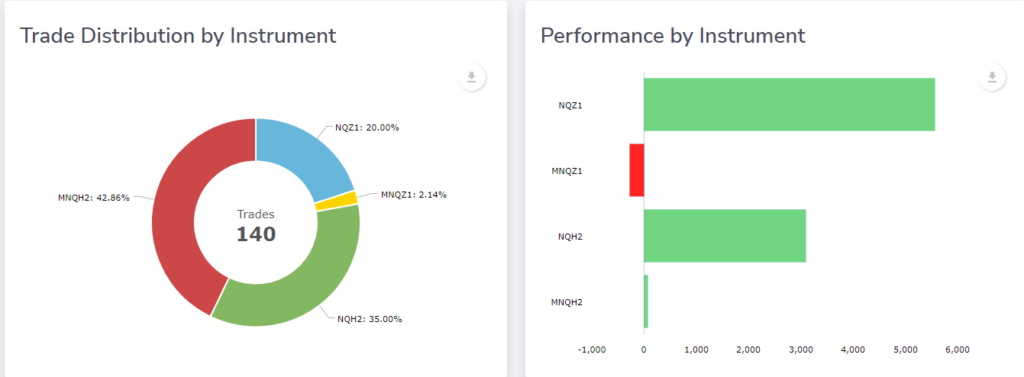
For example, look at this chart below. The scale is horrible, and there is nothing incredible to gain from this that I didn’t know already. Several of the analytics page graphs are similarly designed.
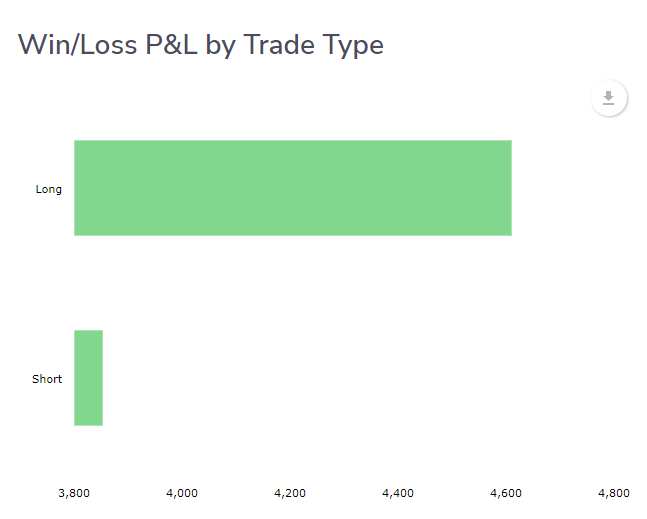
With that said though, their homepage and documentation pages are put together well. It’s not difficult to navigate or find the information that is important to know.
Support Team: 4.5/5
In my experience, the OneUp Support has been great. They respond quickly, and are very patient and polite. Once in a while, you may have an issue take longer than it should, and this has happened to me more than once, but not enough to rate it lower than a 4.5/5.
That’s about all I have to say about the website and built-in chat. Let’s review the actual evaluation of OneUp Trader next.
The Actual Product/Evaluation: 12.5/15
I personally love the evaluation process. I find it to be easy for an experienced trader, and reasonable in just about every way. However, it’s not perfect. In grading the evaluation, I considered the cost, the time it takes to pass, and the rules to follow.
Evaluation/Account Cost: 5/5
The evaluation accounts are priced competitively. The smallest account is one of the cheapest, if not the cheapest, options I’ve found. But the fact that there is no monthly data fee or platform fee associated with the funded account is more important. Traders who come to these programs are usually the ones with little starting capital. I believe that charging them monthly on top of the evaluation and other costs they will incur is counterintuitive.
But most companies do have extra charges, so OneUp Trader maintains a lead over those companies for this reason alone. This brings the total true cost of an account here significantly lower than most of their competition.
Resetting a failed account is an option for those who need it. If you fail early in the month, you might want to reset your account rather than start a new subscription. But it costs $100 to do so. This might be a better deal for someone on the $100,000 or $250,000 accounts, but it is expensive either way. This rate is standard when considering what I’ve seen at other programs.
I’ve broken down the cost of these other companies and compared them here.
Evaluation Length: 3/5
The requirement of 15 days is excessive. It could be reduced to 10, though that may be a biased view. I can earn the required profit in under 10 days, and in the past I’ve had to waste a whole week at times just to tally 15 days. After proving profitability, consistency, and the ability to follow rules, traders ought to be considered capable enough without needing to trade an extra 5 or so days. Some of the competition reduces this time to 10 or even less days, so OneUp Trader can definitely improve in this area.
At the same time, amateur traders will struggle to achieve the required profit in a short period of time. Having 15 days seems fair from the side of OneUpTrader, as a way of filtering out the lucky gamblers.
Evaluation Rules: 4.5/5
The rules for the evaluation are very lenient. This is great, but not so great at the same time.
You must obey the trailing/max drawdown and only trade during the permitted trading times. There are no exceptions for these rules, and that’s perfectly understandable.
But the other rules, like scaling up and trading news events, are essentially non-existent during the evaluation. The consequences here are undesirable from OneUp’s point of view.
In the evaluation, trading news events is permitted, and traders can scale up as much as they want from the start. I imagine this leads to traders taking advantage of news volatility and larger position sizes, perhaps getting lucky, and passing an evaluation easily. Then, once they are funded and have to shorten the leash, they struggle.
A great trader can adjust without issues, but this is simply a flaw in the evaluation in my eyes. However, for an experienced trader, it makes passing the evaluation much easier, which means it’s…an advantage at the same time, right? It just depends on how you look at the opportunity here.
Consistency is required here as well. Basically, you must not profit too much in one day, relative to your other profitable days. Check the example below, taken from their site.
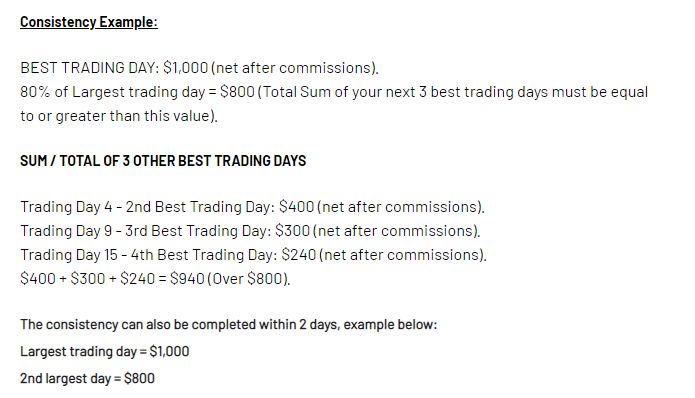
I don’t love this rule, even though I understand the point of it. I’ve had many days where I stopped trading in 5 or 10 minutes because I made too much money too quickly. I believe a good trader should never have to consider exiting a limiting his own profits.
If you want more information about the evaluation itself, be sure to check my full OneUp Trader guide here.
The Funded Account: 12.5/15
When grading the funded account, I am again considering three things. I decided to review the rules, drawbacks, and the profit withdrawal process at OneUp Trader.
Funded Account and Rules: 3.5/5
The funding process is simple and only takes a few business days. Traders have to complete a basic questionnaire and sign a contract, and the funded account will be accessible a few days afterward. While following the same basic rules about maintaining a positive balance and not holding positions past 3:15 PM CST, there are a few additional rules:
- No trading large news events. You must be flat (no open positions) one minute before and after the scheduled news release.
- Follow dynamic scaling targets. No trading max contract sizes from the beginning.
Commissions are real here, so they are a bit lower than the $5 round-trip you will have in the evaluation. But outside of withdrawing profits, which I will cover below, everything else is the same as the evaluation. I think the rules and system here are easy to understand and follow, although I would prefer to be able to trade the news. Their intentions on limiting traders are understandable, but experienced traders can miss out on a lot of profit when they are forced to sit out the news releases.
I also dislike the trailing drawdown which takes open positions into consideration, because it forces traders to take profit before they may otherwise like to. If you’re up $1,000 and the market may pull back and force you out with only $500, you are essentially penalized for not taking your profit earlier. Read more about the trailing drawdown here.
Limitations or Drawbacks: 4/5
One major limitation at OneUp Trader was that traders can only maintain one funded account at a time. This was a huge restriction in my eyes, but as of August 10, 2023, this rule has changed. OneUp now permits up to 3 funded accounts per trader, though you must register them under a different email.
Most traders shouldn’t need more than one, but considering that other programs do often permit more than three accounts, I consider this to still be a bit of a drawback of OneUp Trader.
Changing the rule from 1 to 3 easily bumps the score up to 4/5.
Withdrawing Profits: 5/5
I have to say, after comparing OneUp with other programs, this is the best withdrawal system out there. There are some limitations to withdrawing profit across all of the funding programs, but the best ones are reasonable.
For example, there is often a withdraw threshold, restricting traders from withdrawing profits until they pass this threshold. This is designed to prevent traders from withdrawing all of their profits immediately in the beginning, indirectly testing their consistency and commitment once more.
The wiring process is great. Traders can withdraw as often as they want, provided the request is for at least $1,000 at a time. Considering that other funding programs force traders to wait months at times, it is nice to know you can start withdrawing from the first day, if you hit the ground running.
What Happens if You Fail?
If you fail with the funded account, you simply lose the account. You are free to start another evaluation and attempt to get funded again.
Recently, OneUp also added something called Express Funding. If you’ve blown a funded account in the last 30 days, you can pay for a new evaluation account that only requires 5 trading days to secure funding again. The rules are the same, and the account actually costs more than the normal evaluation, but it saves you 10 days.
You can view the price of these express evaluations below. Each account costs roughly $
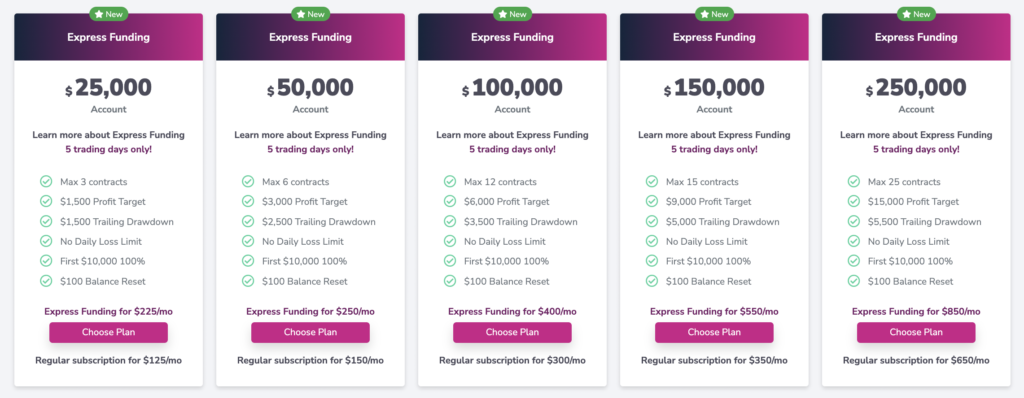
My OneUp Trader Final Score: 36.5/45
I think that covers just about everything to know regarding OneUp Trader. Based on everything included in this review, I would highly recommend OneUp Trader to traders who are looking to earn their own funded trading accounts. There is definitely room for improvement, but the benefits of this program greatly outweigh just about all the drawbacks.
I consider this to be one of the best funding opportunities for futures day trading right now. If OneUp removes their rule on multiple funded accounts, I would find it hard to choose a different company. But until then, traders who decide to manage multiple accounts have to look elsewhere.
If you are still confused about the process here, remember to check out my OneUp Trader guide here. When you’re interested in giving this program a shot, I recommend the $50,000 or $100,000 accounts. The $25,000 is simply not good enough relative to the other accounts, and going over $100,000 may be too much for a first account. You can get started on your evaluation here.
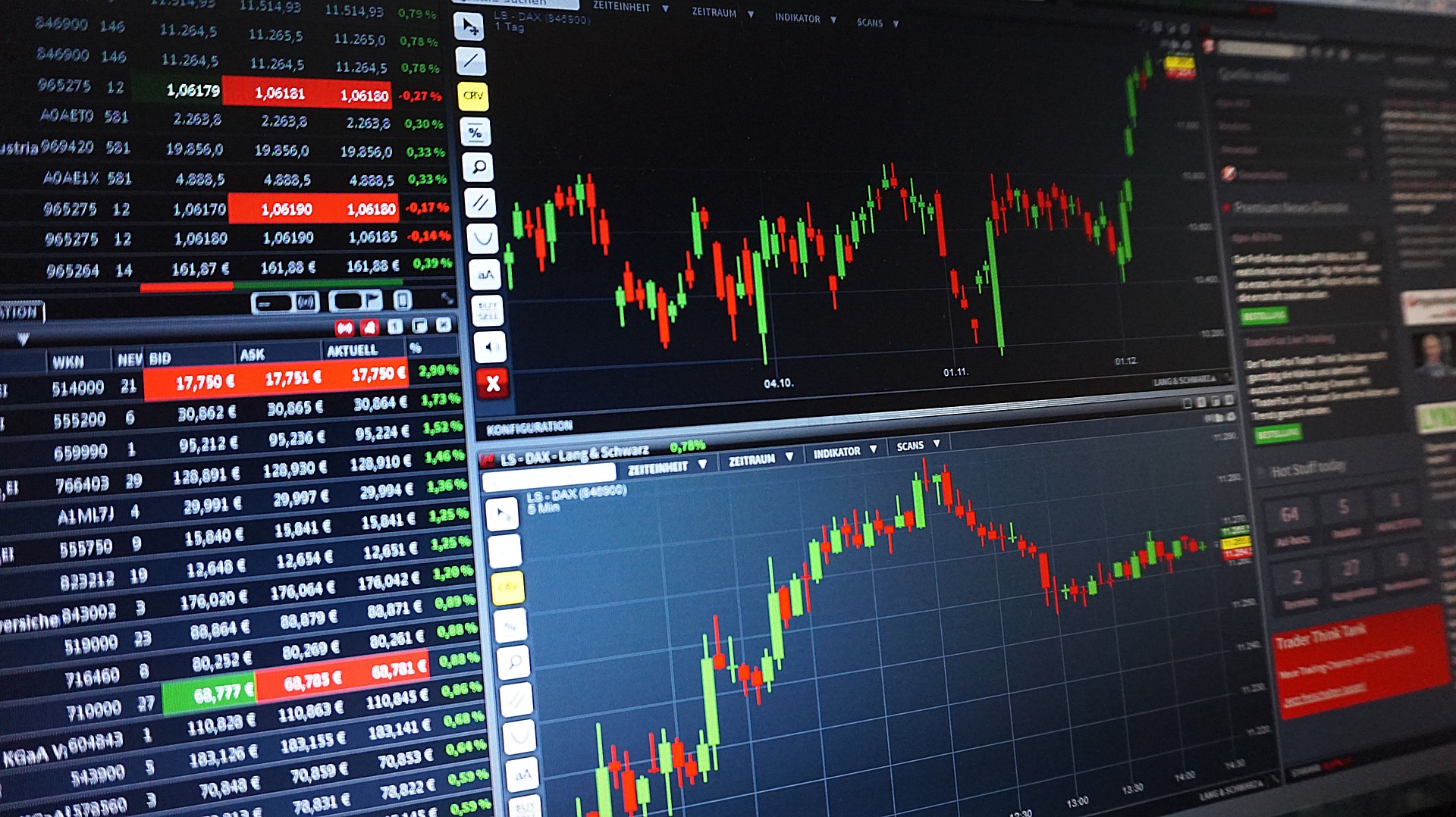
Leave a Reply